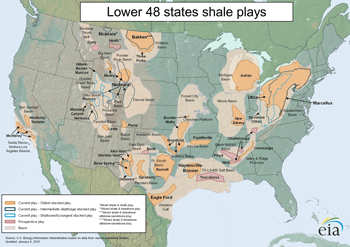A .gov website belongs to an official government organization in the United States.
A lock () or https:// means you've safely connected to the .gov website. Share sensitive information only on official, secure websites.
18 February 2015
modified from the CIRES Press Release

CIRES, NOAA researchers, and colleagues measure lower emissions of the greenhouse gas than some other sites.
Tens of thousands of pounds of methane leak per hour from equipment in three major natural gas basins that span Texas, Louisiana, Arkansas and Pennsylvania, according to airborne measurements published today in the Journal of Geophysical Research: Atmospheres by a NOAA-led team of scientists. But the overall leak rate from those basins is only about one percent of gas production there – lower than leak rates measured in other gas fields, and in line with federal estimates.
"We are beginning to get a sense of regional variation in methane emissions from natural gas production," said lead author Jeff Peischl, a scientist with the Cooperative Institute for Research in Environmental Sciences (CIRES) at CSD. "The gas fields we studied for this paper produced about 20 percent of the natural gas in the United States, and more than half the shale gas, so this moves us closer to understanding methane leaks from U.S. natural gas production."

Peischl and his colleagues used sophisticated measurements taken from a NOAA WP-3D research aircraft to determine methane emissions from the Haynesville, Fayetteville, and Marcellus regions during five flights in the summer of 2013. The data collected for this paper came from the Southeast Nexus (SENEX) mission, which explored the nexus of climate change and air quality in the U.S. Southeast.
Overall, they found that methane leaking from gas equipment totaled about 1.1 percent of gas produced in those regions; estimates from the Environmental Protection Agency, based on average equipment leak rates, put that figure at about 1 percent.
"It is good news that our atmospheric measurements are close to the EPA estimates," said co-author Joost de Gouw, also a CIRES scientist at CSD. "If leak rates are too high, natural gas does not compare favorably with one alternative, coal, in terms of climate impact. Where leak rates are low, the comparison favors natural gas."
In the new study, the researchers also reported their findings by region:

In other published papers, CIRES, NOAA and other researchers have found methane losses of:
The Colorado, Utah and California basins combined produce less than 3 percent of all U.S. natural gas, much less than the eastern basins.
The variable methane leak rates in the different studies suggests that other chemicals emitted during gas production, including compounds that contribute to episodes of poor air quality, are also variable, de Gouw said. There could be many reasons for significant regional differences in leak rates, he added. The composition of gas can vary across different regions, with slightly more or less methane, for example. And equipment, techniques and regulations vary, as well.
The CIRES and NOAA team is planning another aircraft mission this spring, the Shale Oil and Natural Gas Nexus (SONGNEX) mission, to expand emissions measurements from gas-producing regions stretching from Texas to North Dakota. The researchers hope that, taken together, the studies will help industry identify the conditions and techniques that minimize the leaks during gas production, benefitting both the atmosphere and the industry's bottom line.
J. Peischl, T. B. Ryerson, K. C. Aikin, J. A. de Gouw, J. B. Gilman, J. S. Holloway, B. M. Lerner, R. Nadkarni, J. A. Neuman, J. B. Nowak, M. Trainer, C. Warneke, and D. D. Parrish, Quantifying atmospheric methane emissions from the Haynesville, Fayetteville, and northeastern Marcellus shale gas production regions, Journal of Geophysical Research: Atmospheres, doi:10.1002/2014JD022697, 2015.
We present measurements of methane (CH4) taken aboard a NOAA WP-3D research aircraft in 2013 over the Haynesville shale region in eastern Texas/northwestern Louisiana, the Fayetteville shale region in Arkansas, and the northeastern Pennsylvania portion of the Marcellus shale region, which accounted for the majority of Marcellus shale gas production that year. We calculate emission rates from the horizontal CH4 flux in the planetary boundary layer downwind of each region after subtracting the CH4 flux entering the region upwind. We find one-day CH4 emissions of (8.0 ± 2.7) x 107 g/hr from the Haynesville region, (3.9 ± 1.8) x 107 g/hr from the Fayetteville region, and (1.5 ± 0.6) x 107 g/hr from the Marcellus region in northeastern Pennsylvania. Finally, we compare the CH4 emissions to the total volume of natural gas extracted from each region to derive a loss rate from production operations of 1.0–2.1% from the Haynesville region, 1.0–2.8% from the Fayetteville region, and 0.18–0.41% from the Marcellus region in northeastern Pennsylvania. The climate impact of CH4 loss from shale gas production depends upon the total leakage from all production regions. The regions investigated in this work represented over half of the U.S. shale gas production in 2013, and we find generally lower loss rates than those reported in earlier studies of regions that made smaller contributions to total production. Hence, the national average CH4 loss rate from shale gas production may be lower than values extrapolated from the earlier studies.